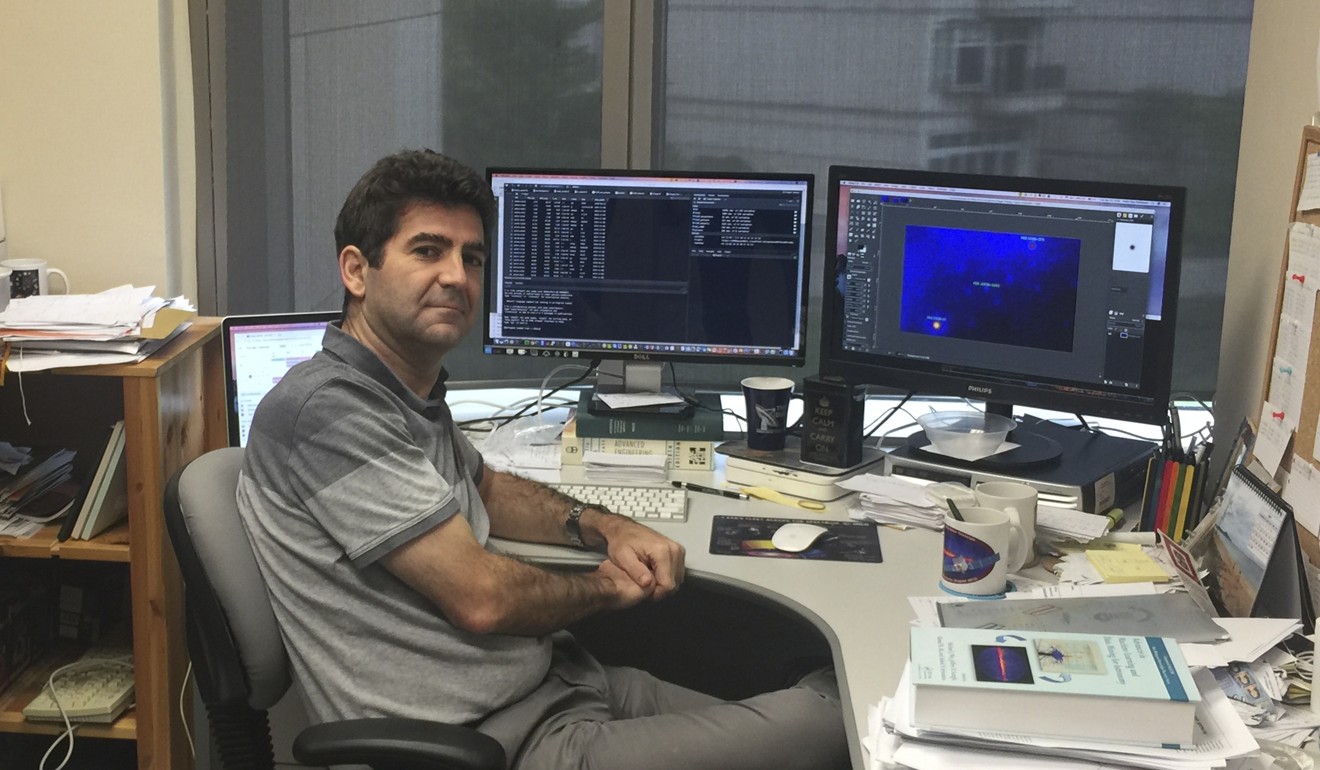
Astronomers detect micro star with double sun’s mass crammed into sphere the size of Hong Kong
‘Lucky’ find was made at the Five-hundred-meter Aperture Spherical radio Telescope, or FAST, in China’s Guizhou province
A team of Hong Kong, mainland Chinese and American astronomers has discovered a rare celestial body that adds to the understanding of the beginnings of the universe using China’s “Heavenly Eye” – the world’s largest radio telescope.
The “lucky” find was made at the Five-hundred-meter Aperture Spherical radio Telescope, or FAST, in China’s Guizhou province earlier this month, and announced in The Astronomer’s Telegram, an internet-based publication that releases information on new observations.
Using Tianyan, as FAST is nicknamed locally, the team detected a new millisecond pulsar, a rapidly spinning micro star with a mass up to twice the sun’s crammed into a sphere the size of Hong Kong.

It was the first significant discovery for Heavenly Eye, whose construction was completed in 2016 and is now in a commissioning phase as instruments are installed and tested.
Team member Pablo Saz Parkinson, a research assistant professor at the University of Hong Kong’s physics department and HKU’s Laboratory for Space Research, said it was an exciting time for the city’s small astrophysics community as the Chinese Academy of Sciences had allowed local scientists “privileged access” to Tianyan so they could try to detect more millisecond pulsars. Only about 250 have been discovered.
Humans have pushed Earth to a terrifying new milestone
The new millisecond pulsar, at 5 billion years old, is much older than standard pulsars, which are usually a few thousand to 100,000 years old. It is about 4,000 light years from Earth and spins once every 5.2 milliseconds.
“It’s roughly much more distant than the sun or the nearest star, which is only a few light years away. The distance to the centre of our galaxy is about 24,000 light years away. So with the new millisecond pulsar about 4,000 light years away, it is a small fraction of that distance,” Saz Parkinson said.
“There are a lot of space projects going on in China these days. It is a very exciting place to be and I think Hong Kong is a great entry point to China. We have the advantage.”
Such a discovery would normally take years but collaboration between astronomers from FAST and Nasa’s Fermi-LAT project speeded up work, Saz Parkinson said.
China’s giant FAST radio telescope to join hunt for extraterrestrial intelligence
“I don’t speak much Chinese but the language of research is English and it makes it easy to work with colleagues here and the director of the HKU lab, an Australian, has a lot of plans of collaboration with mainland institutions. I think there’s a lot of potential in Hong Kong to get involved in a lot of these big Chinese projects.”
He said Fermi-LAT had been exploring the sky for 10 years using gamma rays and was able to pinpoint possible locations of millisecond pulsars.
Saz Parkinson has been applying sophisticated machine learning techniques to Fermi catalogues and produced a ranked list of predicted pulsars among gamma ray sources. It was among these sources that the new pulsar was discovered “a few weeks ago”, he said.
FAST is operated by the Chinese Academy’s National Astronomical Observatories.
“The advantages that we have now with the FAST team is we have some sort of privileged access.
Once the telescope is fully operational, it will run like a national facility so scientists would have to compete for time and write proposals. It will be a competitive process of obtaining time,” he said.
“At the moment we are fortunate enough to readjust, sort of informally send the FAST team these targets and they just get data when they can. And this is why we’ve been lucky to make this early discovery.”
What will happen when our sun dies?
Saz Parkinson said the team hoped to continue to get the chance to use FAST because much of the data would be useful for scientific purposes to make further additional discoveries. Fundamental physics would see some applications.
A well-known example would be the charge-coupled device used in digital cameras, he said. “The first usage of that was to take images in astronomy.”
Another was Wi-fi, “which was primarily developed by radio astronomers”, he said
The pulsars were also direct evidence proving Albert Einstein’s theory of general relativity published in 1916 which explains that the force of gravity arises from the curvature of space and time.
Based on Einstein’s theory, Saz Parkinson said that “when you have many of these millisecond pulsars spread out in space and you’re timing them all for sometime, then that allows you to measure the gravitational waves in between these objects”.
The new pulsar is named PSR J0318+0253 after the coordinates of its location in the sky. Fermi is a Nasa-led mission with a number of international partners including Italy, Japan, France, and Sweden.

